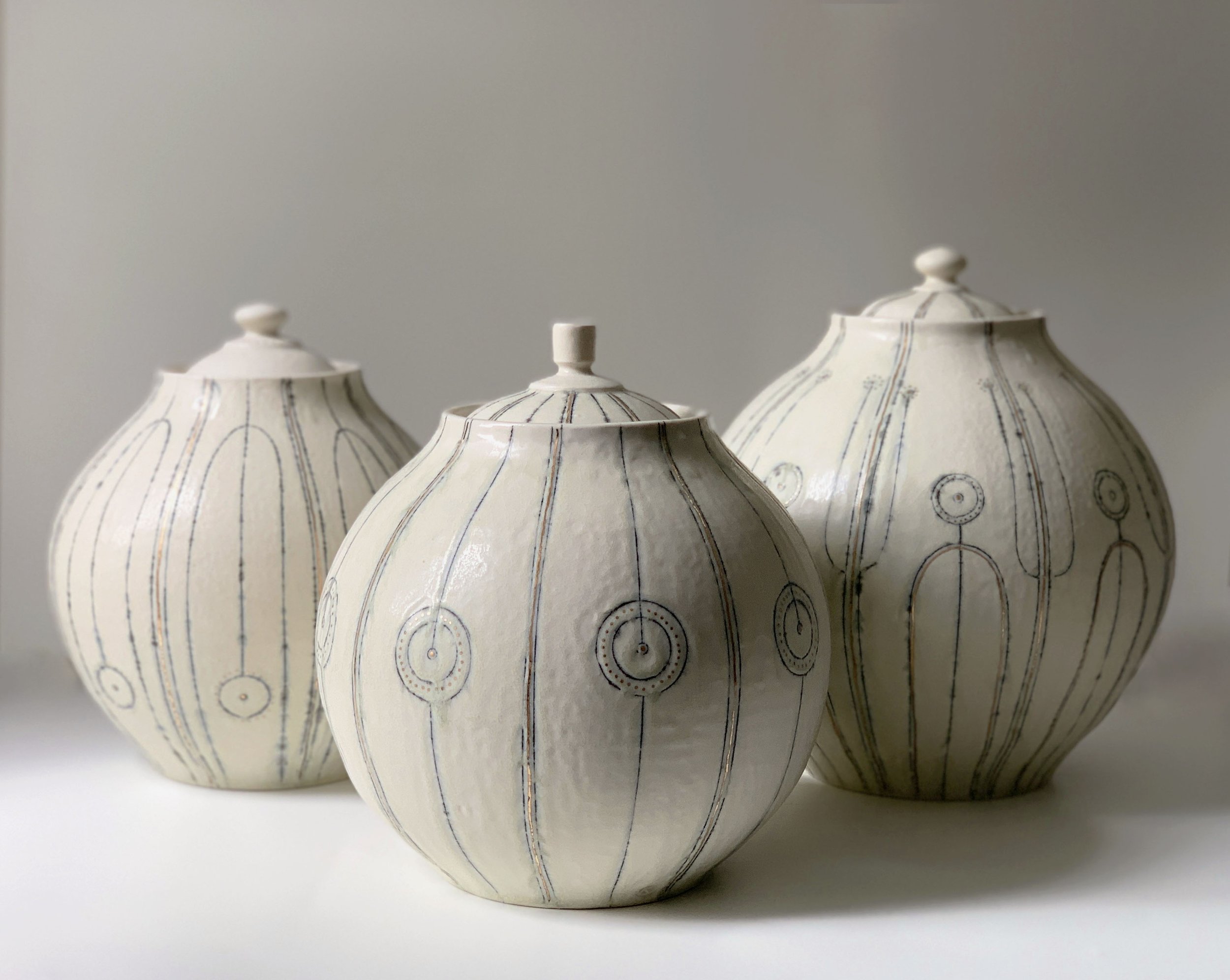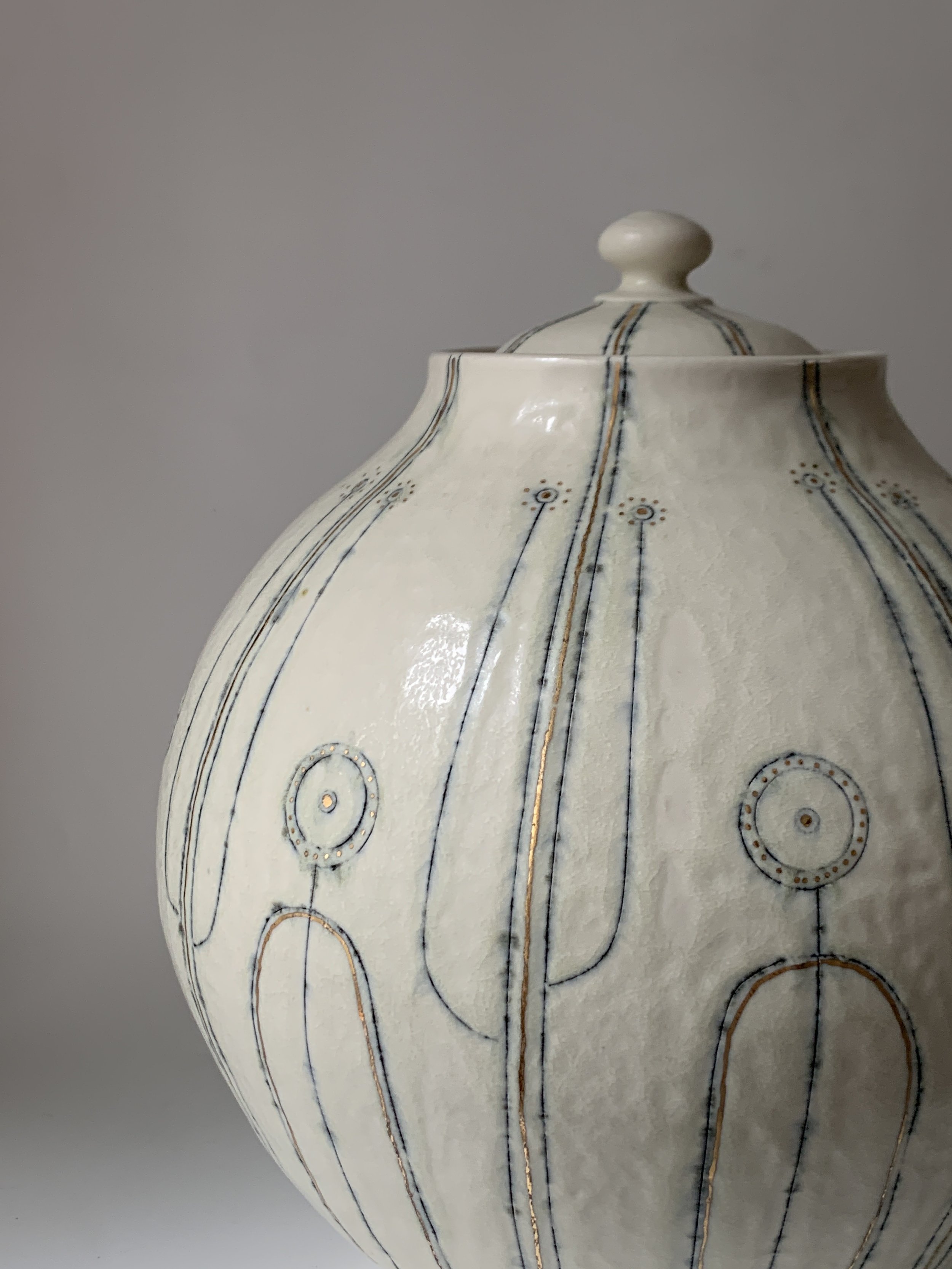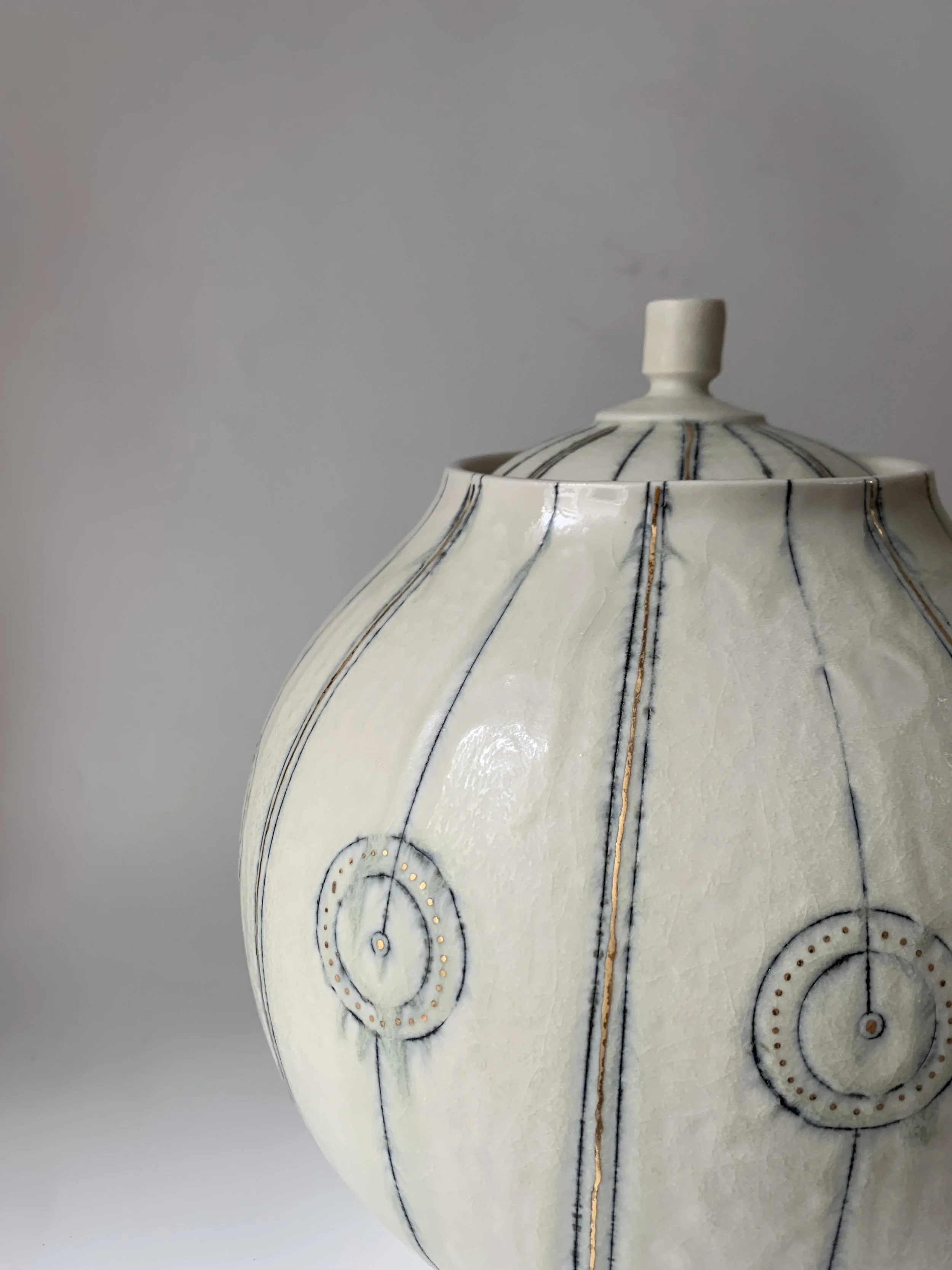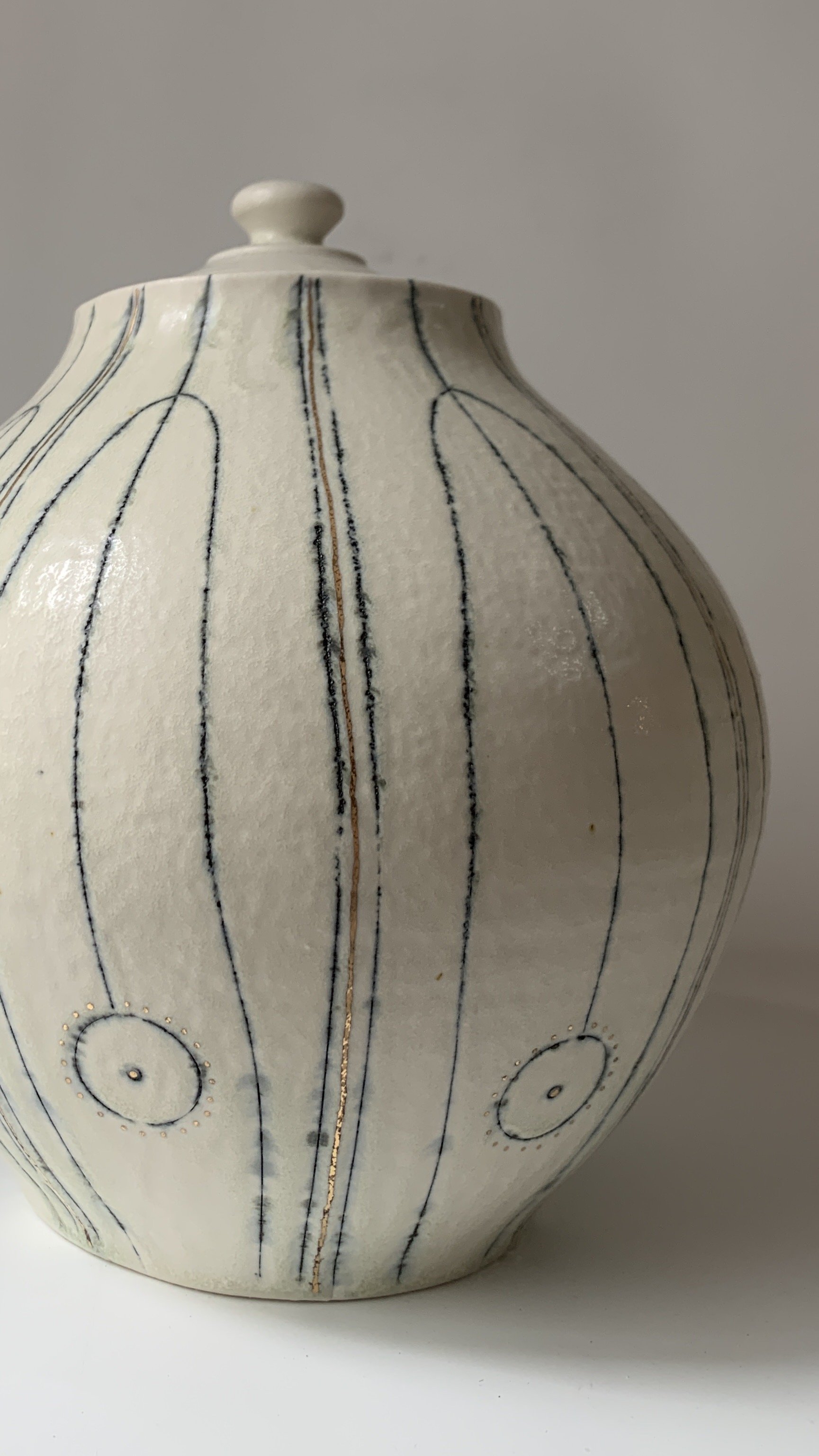Dowry Jars
UPDATE Jan. 13, 2024: This work was selected to be purchased by the State Museum. I’m incredibly honored and humbled to have my work a part of the permanent collection. I’ve added, to the end of the original posting, my artist statement which was presented at the Art of the State Artist Conversations Program on January 7th, 2024 which is sponsored by the Pennsylvania Heritage Foundation.
I’m honored to have work selected for the annual juried exhibit, Art of the State, held at the State Museum of Pennsylvania. The opening reception is scheduled for Sunday September 10th from noon-4pm, free and open to the public.


The Dowry Jars and the historic Pennsylvania Dowry Chests of the 18th and 19th centuries represent examples of material culture that serve to preserve and protect valuable items for future generations. My ceramic jars are just as ornately decorated as their historic counterparts, the linework referencing stages of germination, the gold acting as a highlight to the wonder that it is our natural world. The jars could act as containers foodstuffs or seeds, which across many cultures are the most valuable items to preserve for the survival and prosperity of future generations. The round shape of these vessels also serves as a reminder of the need to protect and invest in our future in more sustainable ways; Earth is the most precious resource we have. Perhaps the most important thing these vessels contain is the hope for our global future.
UPDATE Jan. 13, 2024:
Artist statement presented at the Art of the State Artist Conversations Program (sponsored by the PA Heritage Foundation) on January 7th, 2024:
As an artist, I am driven by the desire to explore the connection between, culture history, and materials through my ceramic vessels. My background and undergraduate degree is in anthropology which has greatly influenced my creative motivations.
Material culture can be defined as the sum of all material objects created by humans. The culture of any society is the web of information that exists in the collective living memory of a community. And we can learn about a culture through their material objects and their ornamentation.
My work is deeply influenced by the material culture of the North, where I lived and studied during graduate school at the University of Alaska Fairbanks. I was fortunate enough to have worked at UA Museum of the North which has a dozen departments dedicated to the study of the circumpolar North. I had been working in the Ethnology and History lab for about all four years of time there. This is where I learned so much about the material culture of the North. I was able to work hands-on with the artifacts and work with researchers, and elders. It was truly a transformative time for me and one that has shaped the way I work in clay.
Many of the ivory objects (such as harpoon heads, handles, combs, sewing kits, utensils, etc) were ornamented with carved designs—much like scrimshaw. They would etch out these designs using a sharpened object and rub lamp black, soot from their oil lamps, into the lines to reveal their carved designs.
There’s a similar process in ceramics. It’s called Mishima. When the clay is leather hard, I cut out my designs, then paint a black slip into them. Once it reaches a certain dryness, I scrape away the excess slip to reveal my design.
I throw my ceramic vessels on a wheel using porcelain clay. Porcelain is the whitest clay body and the smoothest, allowing me to achieve a look and feel that’s as similar as possible to the organic ivory objects that I’m so inspired by.
My forms and glaze patterns recall the shapes of Northern material culture from harpoon heads, baskets, and parkas; while the glaze and kiln firing process reflect the textures associated with natural materials such as bone, ivory, and wood.
The linework that ornaments my pots recalls the linework of the ivory objects I’d been so inspired by. The motifs are very simple, and geometric with the basic straight lines, but also organic in how the lines often reflect the shape of the vessel. I also use repetition and symmetry. A common motif I employ is circles within circles, or the circle and dot motif in my designs. This particular symbol is found cross-culturally. It’s even a common symbol across many disciplines: in philosophy it represents the ego and self, in physics it denotes a vector.
In anthropology, we use the term “liminal” to describe something when it’s in a state of being “in between” or being in two places at once. It’s used when describing shamanistic ceremonies, for example when a shaman is transforming into an animal, they’re in a liminal state between both natural and supernatural worlds. I often use the term “liminal” when describing or titling my work because I feel as though they too straddle a state of existence; they not only contain the food and drink that nourishes, but also contain the ideas of culture and community.
I recently came across books on the subject of PA German folk art and furniture. Thanks to many personal book loans from a family member, I was devouring books on the topic. I learned about the taufscheines (the birth or marriage certificates created for PA dutch communities in the late 1800s) and the frakturs (folk drawings) from that same time period. I learned about their motifs-which included tulips, hearts, stars, birds, the tree of life, and the symbolism behind them. I then learned that these frakturs were historically usually glued to the underside of a chest lid, not on proud display the way we see them most often today.
The chests, which were also ornately painted with similar imagery as the frakturs, were dowery chests. A young woman of marriageable age would accumulate many of her personal belongings in these chests; linens, clothing, grains, cured food, etc and she would take these things (and the skills she learned while preparing them) with her when establishing her own family.
Perhaps because I’d been so recently exposed to this imagery, I started to see some similarities and correlations between these frakturs and the imagery in my work, the elements of design in symmetry, balance, and repetition. Then I started to see the circles and dots in my linework flourishing across my vessels in the same way that the flowers flourish in the frakturs. I started to see that my vessels, also contained my accumulated thoughts and ideas beyond that of the North.
I then started to think about containers, storage vessels, and things that helped various cultures survive and remembered the seed pots of the South Western Pueblo people. These seed pots were very small and round with a teeny opening at the top. This was designed to protect the seeds from critters and keep them dry. When they were ready to plant for the season, they would smash the pot to retrieve the seeds.
Seeds have always been important to the survival of cultures and communities around the world. There are stories of native women sewing seeds into the hems of their dresses to ensure that they would have food wherever the US government sent them. Seeds were important to the survival of the PA Dutch community, even today at the Landis Valley Farm Museum in Lancaster which operates the Heirloom Seed Project, they work to preserve heirloom varieties of vegetables grown throughout the Pennsylvania Dutch region since the 18th century.
When making this set of jars, I was trying to tie all of these ideas together. I wanted the form to be a utilitarian vessel, one that operates as a true container of stored goods (like the dowery chest); the form to be round to recall the seed pots as well as the shape of the earth which we all share, I wanted to implement the liminal line work to remain true to my northern inspiration by way of the circle and dot motif.
The imagery itself recalls the stages of germination; when we plant a seed and nurture it and care for it, it’s able to grow. When the seed erupts from the soil and begins to sprout it’s exciting to see the fruits of our labor and patience pay off in the form of a good crop, one that could then be preserved and continue to nourish us over winter.
For me, the metaphor is that we have many precious resources, both past and present and it’s important that we take notice and find ways to continue to preserve these thoughts, ideas, and most importantly resources for our future generations.
It’s a lot to ask of these three jars to contain all of these ideas, but I’m so glad that the museum will have them in perpetuity and hopefully, they’ll inspire at least one other person in the way that so many things have inspired me.
Many thanks for reading along and supporting my creative endeavors.


